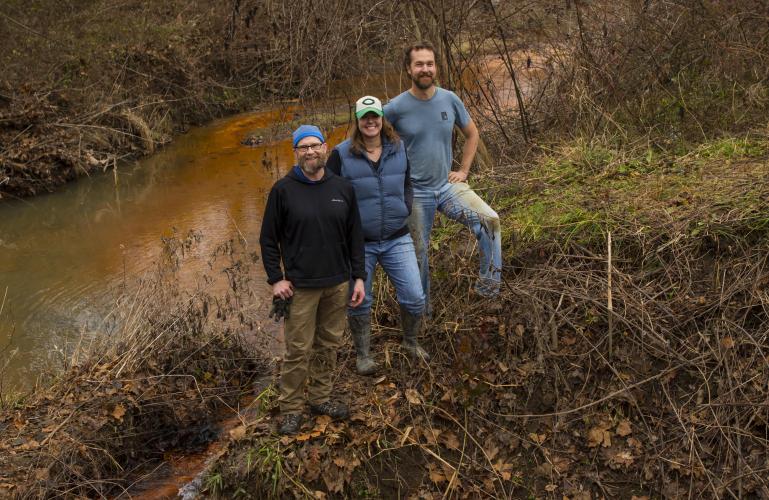
Acid mine drainage cleanup plant moves closer to full scale thanks to $3.5M award

Ohio University, Rural Action and the Ohio Department of Natural Resources (ODNR) are moving forward with a plan that would ultimately construct a full-scale acid mine drainage (AMD) water treatment plant in Millfield, Ohio, after ODNR awarded $3.5 million in pilot funding to the project from the U.S. Office of Surface Mining Reclamation and Enforcement’s (OSMRE) Abandoned Mine Land Reclamation Economic Development Pilot Program.
Over the last decade, Civil Engineering Chair and Professor Guy Riefler in the Russ College of Engineering and Technology has been researching how to remediate acid mine drainage. He has collaborated with Painting and Drawing Chair and Professor John Sabraw in the College of Fine Arts’ School of Art and Design, Rural Action, and dozens of Ohio University students to develop a way to transform iron from acid mine drainage into marketable paint pigments. Encouraged by the success of this partnership’s efforts and the results of its pilot-scale plant in Corning, Ohio, Rural Action has created a new social enterprise called True Pigments, LLC led by Michelle Shively, Sunday Creek Watershed Coordinator.
“We are very excited about the True Pigments business and deeply appreciate our partnership with Dr. Guy Riefler of the Russ College and John Sabraw of the College of Fine Arts,” said Rural Action Chief Executive Officer Debbie Phillips. “This partnership is helping to scale up our work to improve water quality in the region and will result in the restoration of seven miles of Sunday Creek.”
The OSMRE grant will fund the first phase of the project, which is in progress and includes Rural Action acquiring land surrounding the acid mine discharge, arranging financing for the remaining plant costs, and forming the business that will operate the plant and sell the paint pigments. The group aims to create economic opportunities via jobs in small communities that have been impacted by acid mine drainage. Replication of the technology across Central Appalachia could result in the treatment of many more mine discharge sites.
Led by Kaabe Shaw, ODNR Abandoned Mine Land Project Manager, phase one will also map out permits, drainage, the filling of the property, and parking areas. An engineering firm will develop a detailed design of the plant with specifications, which will give the project the credibility needed to secure the remaining funded to complete the project, estimated to cost around $7.5 million.
“We’re working with Rural Action to secure additional support,” Shaw said. “We hope that investors see both the economic and environmental outcomes of this pilot project and finish the treatment plant soon after the site is developed.”
Rural Action is in the process of raising another $4 million through grants, state programs and debt capital to fund the next phase. This phase includes the installation of all the necessary components of the treatment facility, including the master control system, piping systems for water and sludge transport, pumps, aeration basins, clarifiers, thickeners, tanks and pigment drying and packaging systems.
Riefler credited the many students who have been part of the research over the years with its success.
“This technology has really been developed through the creativity and hard work of undergraduate students in class projects, undergraduate researchers, and graduate students,” Riefler said. “The opportunity to have a lasting impact on a local, visible problem has inspired scores of students to enter the environmental field.”
Shaw noted that the collaborative effort between Ohio University, Rural Action and ODNR is unique.
“I think it’s going to actually come about and be something like we’ve never done before in Ohio,” he said.
The group is working to complete construction of the full-scale plant in 2021 or 2022.
